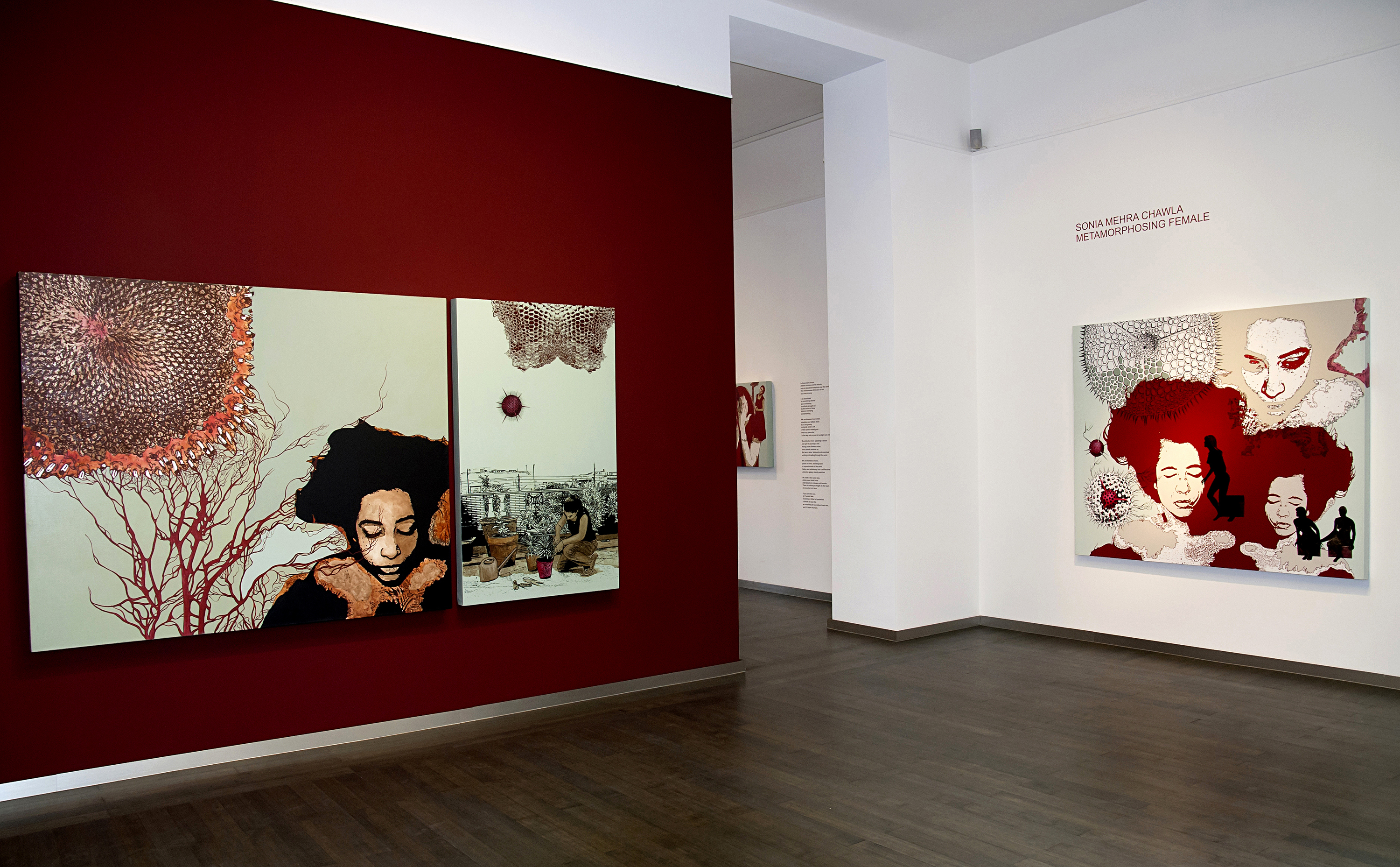

|
METAMORPHOSING FEMALE: TRANSITION TRANSFIGURATION SOLO PROJECT BECK & EGGELING INTERNATIONAL FINE ARTS DUSSELDORF, GERMANY 2011 |
|
 | |
|
As if from a lake I surface for air, mirrors and ripples embracing me through layers of sleep. I greet the chilly dawn, newly-born each morning, cracking through the fragile eggshell air. Botticelli's Venus is brought to mind, born from the lake, her nakedness partially concealed behind long golden hair, looking back at the viewer as we gaze upon her alabaster form of which we are afforded an endless glimpse as angels blow away the drape that another woman is rushing forward with which to cover Venus' modesty. How different is the woman in Sonia's Metamorphosing Female: PURGE, to which these lines refer. Sonia's women also emerge from water, they too are 'newly-born' and they too are self-aware, of their newness, their femininity and the condition of being observed. Yet her women are inward looking, their eyes shut and focused on their own being not 'their-being-as-that-which-is formed-only-in relation-to-the-others-gaze'. Thus they are beings in the universe, i.e. like everything else, formed by a multiplicity of single cells not because they are observed, brought to sight. The graphic patterns on the canvas are inspired by and taken from 18th and 19th century microphotogrpahs, documents and diagrammatic representations of single-celled organisms that occur in the ocean. These cross-sections seem highly complex and ornamental for such base creatures. Sonia has selected fragments from this world to reveal evolutionary mechanics and represent the upward growth of species where single celled creatures are the bottom-most and human beings at the top. And it is these types of cells that are the basis of all life, wherever they may lie on the evolutionary scale. The process of compounded growth is central to Sonia's work as she delves for inspiration into the extremely personal and transformative experience of becoming a mother. The group of works share the title Some Roots Grow Upwards with the painting of the name of a young woman tending to her terrace garden while a fetus grows peacefully in a fleshy placenta like flower. It urges the audience to believe that while the woman in peacefully tending to her plants she is being 'fertile' in both senses of the word and as she nurtures and nourishes the plant so also she does the child to be. The flower, here the pseudo-womb is very Georgia O'Keefe and makes a correlation between the beauty and productivity in plants and humans. If we are to consider 'roots' and thus the deleuzian structure of interconnectedness as being organic and 'un-grid-like' with a central point from which spring almost uncharted paths then in Sonia's work this would be the woman-mother-nuturer. Julia Kristeva has written that with the beginning of motherhood, which begins when a woman gets pregnant, she becomes passionate about herself. This passion for self manifests in an inward 'looking' that is a turning away from the outside stimulants of man-lover-world towards the growing fetus-baby-child. She also uses the phrase 'mystery of gestation' not as a theoretical turn but really to describe how, despite the sciences desire to know the biophysical process of birth, it remains in some part in the realm of the unknowable. The journey is one that begin with extreme narcissism conditioned by the pure physicality of pregnancy and transforms to extreme 'sacrifice' (the child becomes the supreme being for the mother). And thus it may be something both desired and despised (this latter experience is almost always hidden, unspoken, unacceptable). Becoming Light is Sonia's video and sound installation. In its wordy monologues, austere costumes and movements, dramatic lighting, pregnant silences and meaningful gazes it seems to me a cross between Greek tragedy (sans the Woody Allen'esque shrieking), Rembrandt's paintings, any number of instances from the extensive visual tradition, especially European, of women as muse and the visual gestures and evocative translations of mime. It is choppy and disturbing, because in that immersive space surrounded by the three screens, multiple audios and populated by the histories, memories, stories, vulnerabilities and desires of so many unknown women the viewer becomes the one watched and observed. It forces you to confront your own anxieties but robs you of the language with which to articulate a personal narrative because the words attack you, enter you and take over your own voice. What does it feel like, to have no voice? Can you hear your thoughts amidst the cacophony? What does it feel like to be a vessel, a channel? What does it feel like to experience uncontrollable change? What does it feel like to be consistently human? Excerpts from lead essay 'Born of Watery Realms and Fusing Cells; A few thoughts on the transformative experience of the biological imperative', by Deeksha Nath. http://www.aestheticamagazine.com/yinchuan-biennale-2016/ |
|
 |
 |
 |
||
 |
 |
 |
||
 |
 |
 |
||
 |
 |
 |
||